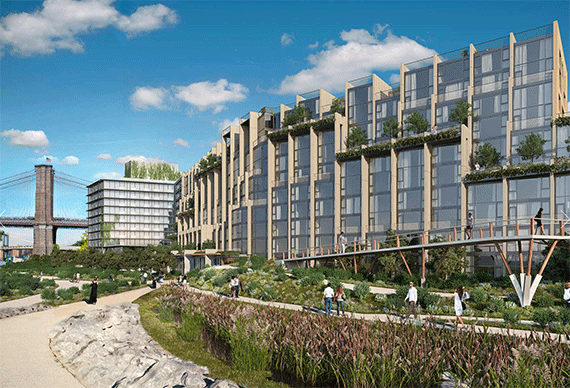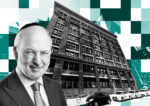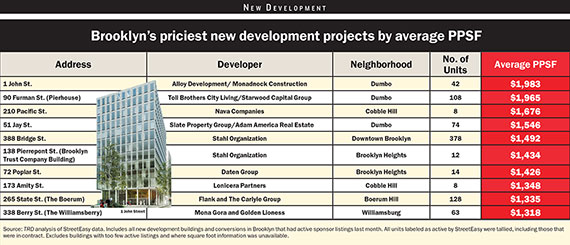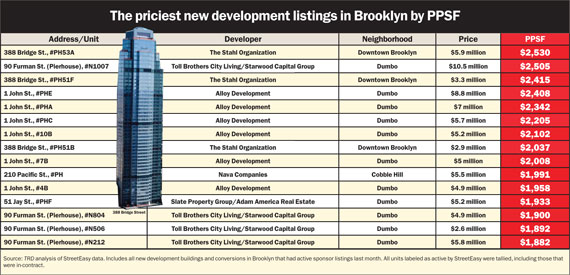Trending
Ranking Brooklyn’s priciest condo developments
Borough’s new condos hit $2,500 </br>per square foot marker

Brooklyn developers are increasingly smashing through a price threshold previously seen only in Manhattan: $2,000 per square foot.
The trend reflects a unique confluence of market realities, namely the borough’s booming popularity and the move toward developments aimed only at the über-wealthy across the East River in Manhattan.
Those price increases are being egged on by the fact that Brooklyn builders are able to offer more impressive amenities, higher-end finishes and top-notch views at prices that rival far more ordinary options on the other side of the Brooklyn Bridge.
“You can get the best apartment in Brooklyn and feel amazing about the purchase, or you can get an average apartment in Manhattan,” said Jared Della Valle, president of Alloy Development, the developer, with Monadnock Construction, of 1 John Street in Dumbo. “I think that’s a psychological opportunity.”
This month, The Real Deal ranked newly built or recently converted Brooklyn residential projects with active sponsor listings by average asking price per square foot, excluding buildings with too few active listings (which would have skewed the averages) and those where square footage information was unavailable.
Of the top 10 projects included, four average more than $1,500 a foot, according to the ranking, which was based on listings pulled from StreetEasy and analyzed by TRD.
The survey also found nine condo units asking in excess of $2,000 per square foot and two units — one at Pierhouse and the other at 388 Bridge Street — exceeding $2,500.
Meanwhile, on the closed sale front, the borough has already seen the $2,000-per-foot line crossed.
In March, a 700-square-foot condo at the Bennett House in Park Slope, a conversion of a 1920s building, sold for $1.4 million, or $2,029 a foot.
Alloy’s 1 John Street, where the average listing price is now $1,983 per foot, took the top spot for priciest building.

Renderings of 1 John Street in Dumbo, Brooklyn
The most expensive listing there, one of six penthouses, is on the market for $2,408 per foot. The 42-unit building sits at the edge of Brooklyn Bridge Park — in the northernmost area — and features kitchens with double islands and bathrooms with stone mosaic floors and freestanding soaking tubs. Every apartment has oversized windows with Manhattan views.
Della Valle said the quality of the units at 1 John Street, his fourth Dumbo project, is higher than those he built at 459 West 18th Street along the High Line in 2010.
Pierhouse — which is being built by Toll Brothers City Living and Starwood Capital Group — has the second highest average listing prices per square foot in the borough, according to TRD’s analysis.
The building provides a clear example of the differences between Brooklyn and Manhattan. For an average $1,965 a foot, Pierhouse buyers get a waterfront location in Brooklyn Bridge Park, with head-on views of Lower Manhattan, 18-foot-high living room ceilings and access to a rooftop swimming pool and bar. For the same price in Manhattan, a buyer can still get high-end finishes but would get ordinary ceiling heights, second-rate views, standard layouts, and only obligatory amenities crammed into smaller spaces, sources said.

Rendering of Pierhouse in Brooklyn Bridge Park (credit: Rogers Marvel Architect)
Sources say since many of today’s projects were penciled out a few years back when Brooklyn land costs were a bit lower, developers have more financial flexibility to go over the top with designs and finishes — and then ramp up prices.
No compromises
Like Della Valle, developers building in Brooklyn are increasingly deciding to go all-out, often guided by new development marketing firms that convince them that Brooklyn buyers are also willing to spend more than they have in the past.
“The housing stock that was being built seven years ago was for the first-time homebuyer,” said Stephen Kliegerman, president of Halstead Property Development Marketing, which is selling several Brooklyn projects including 388 Bridge and 51 Jay. “Now the housing stock that’s being built is for folks who might be on their second or third purchase.”
Nava Companies founding partners David Ruff and Stewart Osborne weren’t expecting to break $1,200 to $1,300 a foot when they started 210 Pacific Street in 2011. So they initially opted for more basic finishes. Those finishes were, however, ultimately upgraded.
“Through conversations with the brokers, we realized that the product we initially intended to bring to the market would bear out a lower PPSF than the one we ultimately decided to bring to market,” said Ruff. “We upgraded a number of things based on the demand we saw.”
They listed the units in the environmentally sustainable building — which includes a rooftop solar hot water heater and electric car charging — for an average of $1,676 per foot, placing the building third on TRD’s ranking. The duo launched sales in January and have just two remaining units, including the penthouse, which hit the market in late April for $5.5 million, or $1,991 per foot.
Not far away in Brooklyn Heights, developer David Ennis said he would have been happy to break $1,000 a square foot when his company, the Daten Group, began planning its 14-unit condo at 72 Poplar Street back in 2011. A three-bedroom penthouse at the project, a conversion of a former police horse stable that includes an adjoining townhouse, is now in contract for north of $1,900 per foot. (TRD included in-contract units labeled as “active” in StreetEasy.)
“That we’re even discussing $2,000 a foot [now] is phenomenal,” he said. The overall average in the building was $1,426 per foot, which put the project at No. 7 on the ranking.
In response to prodding from the marketing team at Douglas Elliman, Ennis decided to dial up the style and quality of his project.
“At $2,000 in Brooklyn there will still be that expectation that you get everything,” Ennis said. For example, the townhouse will have a heated and cooled garage, radiant-heated floors and three levels of outdoor space. As a result: There’s no compromise. In Manhattan, $2,000 is now a compromised number in the same way that $1,200 was a few years ago, Ennis said. In other words, buyers in Manhattan are not getting top-notch new developments at that price today.
Price hiking
At $2,530, the most expensive single unit on the market by price per square foot is a penthouse at the Stahl Organization’s 388 Bridge Street in Downtown Brooklyn that’s asking nearly $6 million.
The 53-story condo-rental hybrid had an average asking price of $1,492 per foot for its active listings, putting it at No. 5 on the ranking. The priciest units have panoramic views of the Manhattan skyline and New York Harbor.
Roger Fortune, Stahl’s vice president, said that $6 million is a great deal for the penthouse — “less than half the price of comparable Manhattan apartments” — considering the fact that it is the tallest condo in Brooklyn and comes with an impressive amenities package, including a 536-square-foot private terrace.
Though achievable asking prices have skyrocketed in the past four years, they’re not letting up. It’s now common for Brooklyn developers to increase condo prices after sales launch.
“On a couple units we had multiple bids, and so we increased the prices when we were going through that process,” Ruff said of 210 Pacific. “It’s been very fluid and we’re kind of weekly monitoring where we think the market is.”
Some developers say they could easily hike prices, but have decided to get out closer to their original projections, while letting buyers feel good about the value they’re getting.
Architecture and development firm Flank launched sales at its 128-unit condo the Boerum at 265 State Street in Boerum Hill in December, and is in-contract on 95 units, according to StreetEasy.
Flank co-founder Mick Walsdorf said the firm could charge more than the average $1,335 per foot the units are listed for in the building. But, he said, the company, which has increased prices marginally since launching sales, is happy with the quick absorption. The project clocked in at No. 9 on the ranking.
Walsdorf said he believes prices could be increased by $50 to $75 per square foot across the board without hurting absorption rates, while his colleague estimated that number at $100 more per foot.
Price projections
While condo prices in the city’s hippest borough have risen substantially, on the whole they are still a long way off from mirroring the overall Manhattan market.
In Manhattan, only a handful of new development buildings now have price-per-square foot averages under $2,000, and those at the very top, like Macklowe Properties’ and CIM Group’s 432 Park, are listing units for averages topping $7,500 a foot.
Walsdorf said he expects $1,400 to be the new entry point for condo development in prime Brooklyn neighborhoods — and to go up from there.
That’s not to say that there aren’t projects outside of prime Brooklyn neighborhoods with lower price points.
According to TRD’s research, 875 Saint Marks Avenue in Crown Heights has an average asking price of $533,000, or $654 per foot.
The up-and-coming Crown Heights — along with Prospect-Lefferts Gardens, Clinton Hill, and Bedford-Stuyvesant — is one of the only Brooklyn neighborhoods left that has an easy commute into Manhattan and where developers are constructing condos in this price range. Not surprisingly, the demand is enormous, sources said.
The most bullish believe that in prime Brooklyn — generally considered Dumbo, Brooklyn Heights, Boerum Hill, Cobble Hill and Williamsburg — prices are headed for an average of $2,000 a foot.
“I know there are sporadic deals at $2,000 a foot, but I’m talking about pushing to an average of $2,000 a foot,” Kliegerman said. “The stretch from $1,500 a square foot to $2,000 a square foot is still quite significant.”
Daten’s Ennis said, however, that he’s wary of $2,000 a foot becoming the average in Brooklyn, except for very special units.
“In 2015, our new thought process is breaking $1,500 a foot,” he said. His firm’s next project will be a condo building in Prospect Heights that will aim for this price range.
While rising Manhattan prices have led to concerns about the pool of global buyers drying up, sources say the Brooklyn buyer pool is deep, with increasing numbers of New Yorkers, West Coast transplants, and foreigners seeking it out as their first choice.
“I think the likelihood that Brooklyn will catch up to Manhattan is higher than Manhattan continuing to escalate at the pace it had. And I think our buyers believe that too,” Della Valle said. “People buy into the fact that Brooklyn is $2,500 per square foot in prime, prime, prime locations more than they do that Tribeca is $5,000 per square foot,” he added.
Ruff also drew a comparison to trendy Tribeca, where the top of the market for family-sized apartments in new buildings hits $6,000 a foot, with many falling in the $2,000-to-$3,000 range.
“A lot of Tribeca and West Village buyers with families want that extra bedroom or two bedrooms and see a value proposition in an $1,800, or even $2,000, square foot unit with the amenities that we provide that would really be out of reach in Tribeca,” Ruff said.
What’s more, some developers are making personal investments in Brooklyn by choosing the borough as their home.
Nava’s Osborne, who has lived in Brooklyn for 18 years, said it’s an easy decision. “For us, the quality of life question is not a question, it’s just an obvious thing,” he said.
Della Valle lives in at 185 Plymouth Street, a former Brillo warehouse in Dumbo that Alloy converted, while the firm’s CEO, Katherine McConvey, purchased a Dumbo townhouse the company also developed.
But lest these Brooklyn developers get too big for their britches, sources say the borough is still no threat to Manhattan’s dominance of the ultra-high-end market.
“Manhattan has for many, many years on Central Park achieved prices that rival any city in the world. Brooklyn hasn’t done that,” Kliegerman said. “Could it get there one day? Yes. Do I see it happening in the near future? No I don’t. And that’s not a bad thing. There’s only one Central Park. It’s still in Manhattan.”






